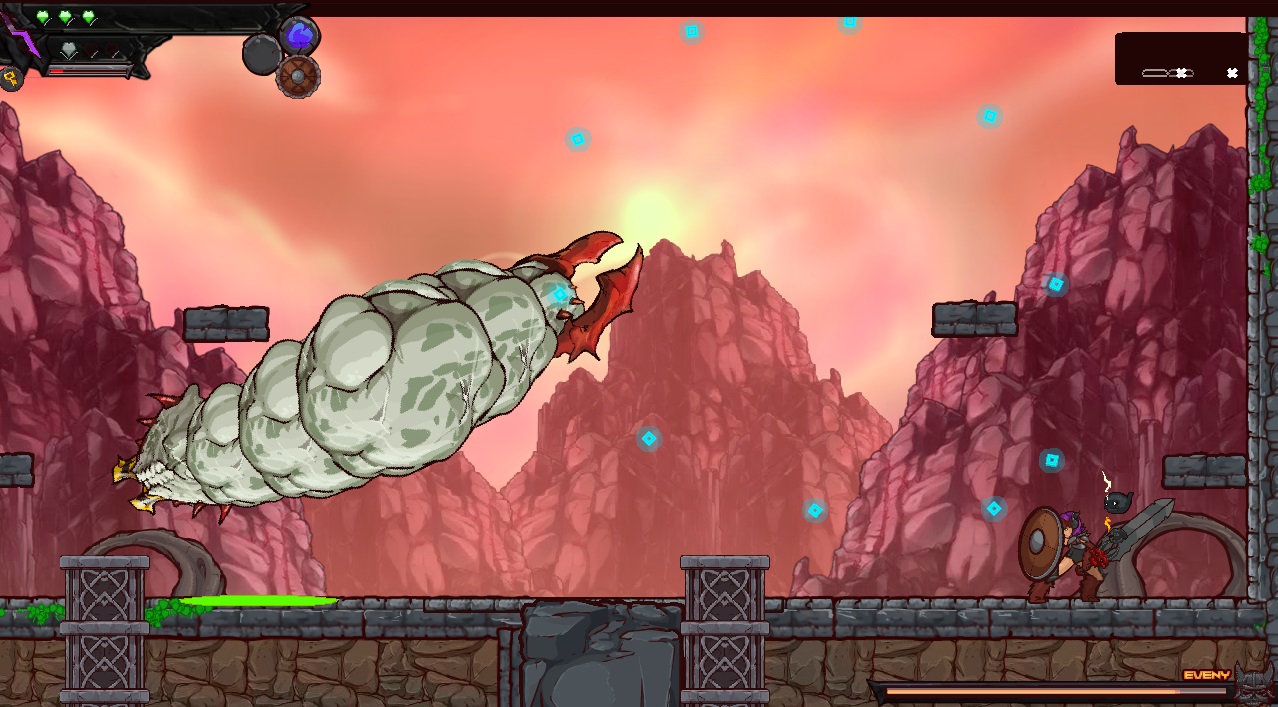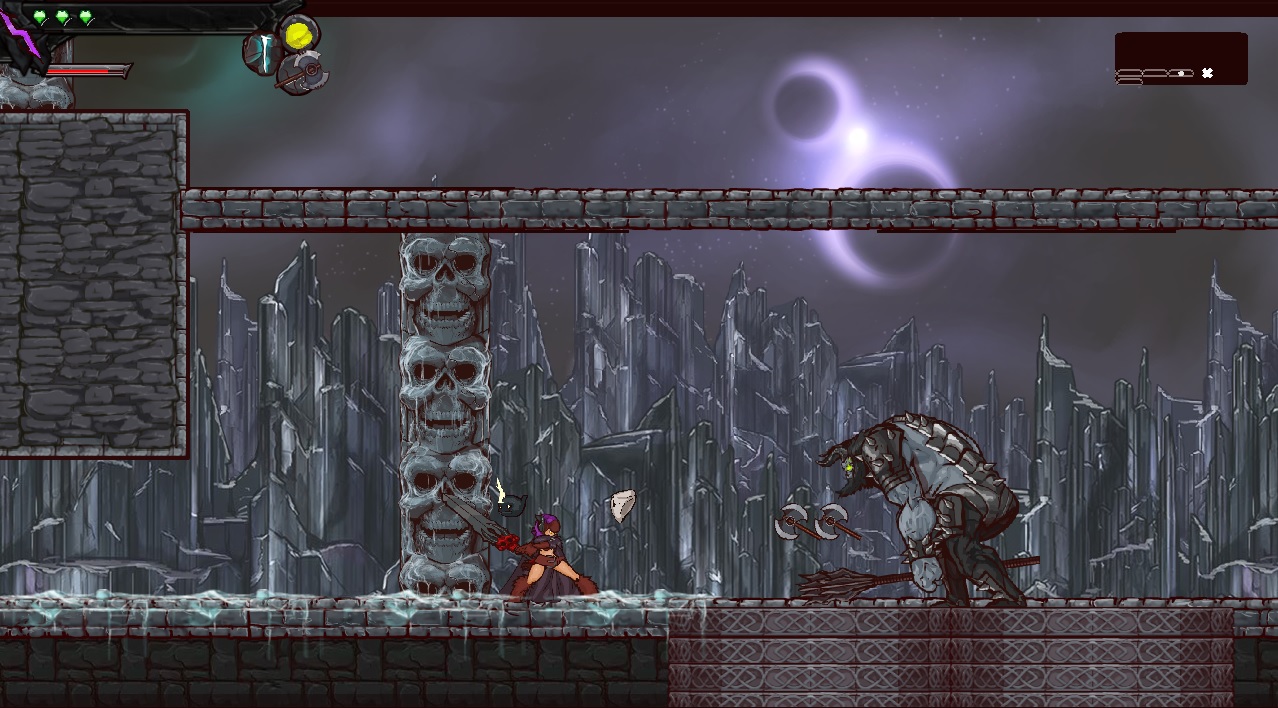Search
[{{{type}}}] {{{reason}}}
{{/data.error.root_cause}}{{{_source.title}}} {{#_source.showPrice}} {{{_source.displayPrice}}} {{/_source.showPrice}}
{{#_source.showLink}} {{/_source.showLink}} {{#_source.showDate}}{{{_source.displayDate}}}
{{/_source.showDate}}{{{_source.description}}}
{{#_source.additionalInfo}}{{#_source.additionalFields}} {{#title}} {{{label}}}: {{{title}}} {{/title}} {{/_source.additionalFields}}
{{/_source.additionalInfo}}Tyrfing Cycle |Vanilla| (PC)

Tyrfing Cycle |Vanilla|
Developed By: Demon Sword Games
Published By: 378 Publishing LTD
Released: April 15, 2016
Available On: Windows
Genre: Hack and Slash
ESRB Rating: N/A
Number of Players: 1
Price: $7.99
Thanks to Demon Sword Games for the review key!
Summoned by Thor, the berserker Hervor is given a task simple in concept but strenuous in execution. She is to chase down a man named Angantyr, who is rumored to be plotting against the gods – and who happens to be both Hervor’s father and the previous owner of her magic sword Tyrfing. As she travels to Helheim to discuss his whereabouts with Hel, the goddess of the dead, Hervor prepares for great honor or a grand death – though the second will escape her until the mysterious figure she’s bound to is through with her.
Tyrfing Cycle is a side-scrolling hack-and-slash with light platforming and Roguelike elements. You control the aforementioned Hervor, cutting your way through semi-randomly generated levels: the game takes its rather expansive list of pre-built rooms and jams them together. Hervor starts with nothing but her sword Tyrfing, but picks up sidearm weapons, magic, armor pieces, liquid souls, and faerie helpers to up her arsenal. Each realm you visit – Helheim, Jotunheim, and (theoretically) Svartalfheim – consists of two full levels with a random end boss, and a third with only a harder, more complicated boss to fight. Dying at any point forces a restart, though you can usually power up Hervor for the next run depending on how well you did before.
While the basic melee combat is fast-paced and entertaining, Hervor’s moveset with Tyrfing is rather limited, and one of her few attacks is vastly superior to the others. When combined with both the wealth of secondary attacks and the enemy design, however, combat becomes a thoroughly satisfying affair. Attack-wise, you can randomly find any of five magic spells, five sidearms, five faeries, nine souls, and nine pauldrons. The first two are player-activated attacks, either spitting an area-of-effect magic spell or tossing a ranged weapon like a boomerang or axe; the faeries attack nearby enemies with magic; and the souls and pauldrons offer passive buffs to Hervor, such as increased damage, double-jumping, or health and magic regeneration. In addition, you can unlock armors for Hervor that both change her look and come with some upgrades already in place, and depending on your last run’s progress you can have one to three choices of upgrades to start with. In short, there is certainly no shortage of options when it comes to the gameplay.

Strong Points: Combat is fast-paced and skill-based; lots of power-up options
Weak Points: The power-ups are poorly explained; very, very buggy; abandoned for its similarly-named remake
Moral Warnings: Steeped in Norse mythology; one loading screen type is a pentagram; a few skeletal enemies; bloody but corpseless violence; magic use; bikini armor
Aiding in the combat is the enemy design; there are a decent variety of foes to face, and all are equal parts deadly and predictable. With few exceptions, every monster has the potential to rapidly drain Hervor’s health if you’re not paying attention, but all have set patterns and attack tells that make every attack avoidable. This applies to the bosses as well: there are over a dozen unique bosses in the game (and a few palette swaps), and every one is capable of both wiping the floor with you and being utterly demolished depending on the player’s familiarity and skill level. While some enemies are certainly easier than others, nearly all of them will keep you on your toes in one way or another, making for an engaging, satisfying experience. There’s a decent amount of content as well, with a boss rush mode and three loadout-based challenges, so there’s plenty to test your mettle and reflexes against.
The controls do their job, with Hervor responding well but tending to be a little floaty with her jumps. This is, however, a game where a controller works much better than a keyboard. The keyboard controls are by no means bad – with the exception of the pause button being hidden away on the P key, all of Hervor’s actions are grouped together at the arrow keys, W, A, S, D, and E. However, the controller has one extra movement option that the keyboard doesn’t have, and is rather important to the flow of the game. On the keyboard, pressing A makes Hervor quickly cartwheel backwards, giving both speedy movement and invincibility frames; on the Xbox 360 controller, the two triggers act as the dodge buttons, sending Hervor left or right on command – meaning you can dash forwards as well. That, along with analog movement, makes the controller the superior option, though it’s by no means unplayable with the keyboard.
Presentation-wise, Tyrfing Cycle is coherent and pleasing. The graphics are solid all-around, and while the animation on the enemies isn’t always the greatest, particular care was given to Hervor, who animates splendidly. The cutscenes at the beginning are done in a charming, well-drawn comic-book style, and it’s too bad that you can’t see them again without wiping your data completely. The music is low in number but high in quality, giving a sort of energetic, hard-rock backbeat to the action. Hervor has some light voice acting, limited to combat-related grunts and “die,” and this is both convincing and fitting to the character. There was a clear vision to this game’s style, and it comes through very competently.

Higher is better
(10/10 is perfect)
Game Score - 77%
Gameplay - 16/20
Graphics - 8/10
Sound - 8/10
Stability - 2/5
Controls - 4.5/5
Morality Score - 69%
Violence - 4/10
Language - 10/10
Sexual Content - 6.5/10
Occult/Supernatural - 5/10
Cultural/Moral/Ethical - 9/10
There are, unfortunately, two big issues dragging this game down. The first revolves around the power-ups: while the choices are there, the explanations are not. When you pick up an item in-game, it gives you a little description on the bottom of the screen – and this is the only time the game will tell you what an upgrade does. With magic and sidearms, it’s less of an issue, since you can just use them to figure out their effects. With the liquid souls and pauldrons, however, the text boxes are your only clues to their benefits. These are found rather rarely in the stages, and with nine each to choose from, it becomes rather unlikely that you’ll ever see one specific item pop up, save for those that are specifically dropped by enemies. Sure, you can extrapolate their uses though careful observation, but there really should be a menu screen detailing each power-up somewhere in the game.
Second, and much more importantly, is the game’s stability. To put it simply, the game is buggy. The title screen takes a few seconds to respond to controls. Achievements exist, but don’t unlock. Selecting a liquid soul at the pre-run upgrade menu never actually gives it to you. Armor-specific upgrades sometimes, but not always, reappear after each level if you’ve replaced one with something else. Rooms don’t always fit together properly, sending Hervor into the floor or walls on the screen transition and potentially requiring a restart. The cutscene after the final boss of Helheim displays no graphics, only text boxes. Beating the first boss in Jotunheim doesn’t stop the boss music, eventually leading to it halting altogether. The game usually crashes somewhere in the second level of Jotunheim. The one time I made it to and defeated the boss of said second level, the game punted me back to the start of Helheim. You can’t quit the game – the “are you sure” box after selecting the option has “back” as the only choice, requiring you to manually close the game window. Don’t expect these to get fixed, either: the developer has moved on to the non-“Vanilla” version of the game, which looks to be a very similar, though apparently different, experience. It’s a shame to see such a promising game bogged down in bugs and potentially abandoned, but so it goes with Early Access.
Like the hard-rock theme would suggest, Tyrfing Cycle has its fair share of morality issues. As you’d expect from a game named after a collection of Nordic legends, Tyrfing Cycle is heavy on Norse mythology, with every character and enemy taking direct or indirect reference to the tales. One of the loading screen variants is a pentagram, with the icons of the elemental magic spells the player can use dotting each point. A few enemies are undead, namely a skeletal dragon head and a giant skull boss. Violence is the main draw of the game, and everything, including Hervor, bursts into blood droplets upon death, though at least no corpses are left. Finally, though it depends on the armor selection, Hervor shows quite a lot of skin, with her default outfit being essentially a leather bikini – Hel, the only other humanoid character to make an appearance, isn’t covered much either. While it might not get as bad as it could, there’s still quite a bit to comb through before giving this one to younger or more sensitive types.
Tyrfing Cycle is a game with immense, but ultimately squandered, promise. The game is great, to be sure, but only when it works – and it doesn’t work that often. If the bugs were cleaned up and/or the developer was more active, the $7.99 asking price would be a steal. As it is, though, it’s hard to recommend, especially with the pseudo-remake currently sitting at around half the price. For what it’s worth, though, you might want to check out the non-Vanilla version; if it picks up where this one left off, it’ll have a lot going for it.
-Cadogan






